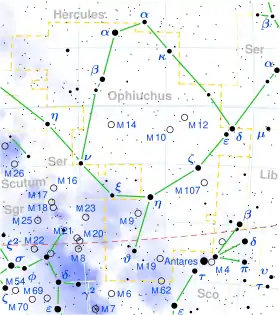Upsilon Ophiuchi
Upsilon Ophiuchi is a triple star[12] system in the equatorial constellation of Ophiuchus. It has a white hue and is faintly visible to the naked eye with an apparent visual magnitude of 4.62.[2] The distance to this system is approximately 134 light years based on parallax.[1] It is drifting closer with a radial velocity of −30.6 km/s.[5]
| Observation data Epoch J2000 Equinox J2000 | |
|---|---|
| Constellation | Ophiuchus |
| Right ascension | 16h 27m 48.18720s[1] |
| Declination | −8° 22′ 18.2245″[1] |
| Apparent magnitude (V) | 4.62[2] |
| Characteristics | |
| Spectral type | kA2hA5VmA5[3] |
| U−B color index | +0.06[4] |
| B−V color index | +0.16[4] |
| Astrometry | |
| Radial velocity (Rv) | −30.60[5] km/s |
| Proper motion (μ) | RA: −67.49[1] mas/yr Dec.: −11.75[1] mas/yr |
| Parallax (π) | 24.42 ± 0.91[1] mas |
| Distance | 134 ± 5 ly (41 ± 2 pc) |
| Absolute magnitude (MV) | 1.75[2] |
| Orbit[6] | |
| Primary | Aa |
| Companion | Ab |
| Period (P) | 27.218±0.0005 d |
| Semi-major axis (a) | ≥ 0.0583 AU |
| Eccentricity (e) | 0.744±0.002 |
| Periastron epoch (T) | 2,438,914.84±0.01 JD |
| Argument of periastron (ω) (secondary) | 333.7±0.7° |
| Semi-amplitude (K1) (primary) | 34.9±0.3 km/s |
| Semi-amplitude (K2) (secondary) | 41.1±0.3 km/s |
| Orbit[7] | |
| Primary | A |
| Companion | B |
| Period (P) | 82.8±1.4 yr |
| Semi-major axis (a) | 0.79±0.03″ |
| Eccentricity (e) | 0.45±0.03 |
| Inclination (i) | 31.2±5.7° |
| Longitude of the node (Ω) | 86.8±6.9° |
| Periastron epoch (T) | B 1994.1±1.0 |
| Argument of periastron (ω) (secondary) | 177.9±7.4° |
| Details | |
| Mass | 1.94[8] M☉ |
| Radius | 1.9[8] R☉ |
| Luminosity | 16.56[2] L☉ |
| Surface gravity (log g) | 4.45[9] cgs |
| Temperature | 8,364[9] K |
| Metallicity [Fe/H] | +0.14[2] dex |
| Rotational velocity (v sin i) | 44[10] km/s |
| Other designations | |
| Database references | |
| SIMBAD | data |
The variable radial velocity of the brighter component was first observed by H. A. Abt in 1961. It is a double-lined spectroscopic binary system with an orbital period of 27.2 days and an eccentricity of 0.74.[6] They have a combined magnitude of 4.71. Both components are similar stars with a combined stellar classification of kA2hA5VmA5, and one or both are Am stars.[3] The third component has an 82.8 year orbit with the inner pair at an eccentricity of 0.45.[7] The system is a source for X-ray emission.[13]
References
- Van Leeuwen, F. (2007). "Validation of the new Hipparcos reduction". Astronomy and Astrophysics. 474 (2): 653–664. arXiv:0708.1752. Bibcode:2007A&A...474..653V. doi:10.1051/0004-6361:20078357. S2CID 18759600. Vizier catalog entry
- Anderson, E.; Francis, Ch. (2012). "XHIP: An extended hipparcos compilation". Astronomy Letters. 38 (5): 331. arXiv:1108.4971. Bibcode:2012AstL...38..331A. doi:10.1134/S1063773712050015. S2CID 119257644. Vizier catalog entry
- Abt, Helmut A.; Morrell, Nidia I. (1995). "The Relation between Rotational Velocities and Spectral Peculiarities among A-Type Stars". Astrophysical Journal Supplement. 99: 135. Bibcode:1995ApJS...99..135A. doi:10.1086/192182.
- Mallama, A. (2014). "Sloan Magnitudes for the Brightest Stars". The Journal of the American Association of Variable Star Observers. 42 (2): 443. Bibcode:2014JAVSO..42..443M.Vizier catalog entry
- Wilson, R. E. (1953). "General Catalogue of Stellar Radial Velocities". Carnegie Institute Washington D.C. Publication. Carnegie Institution for Science. Bibcode:1953GCRV..C......0W. ISBN 9780598216885. LCCN 54001336.
- Gutmann, F. (1965). "A study of the spectroscopic binary 3nu Ophiuchi (HD 148367)". Publications of the Dominion Astrophysical Observatory Victoria. 12: 391–399. Bibcode:1965PDAO...12..391G.
- "Sixth Catalog of Orbits of Visual Binary Stars". United States Naval Observatory. Retrieved 24 May 2017.
- Allende Prieto, C.; Lambert, D. L. (1999). "Fundamental parameters of nearby stars from the comparison with evolutionary calculations: Masses, radii and effective temperatures". Astronomy and Astrophysics. 352: 555–562. arXiv:astro-ph/9911002. Bibcode:1999A&A...352..555A. Vizier catalog entry
- David, Trevor J.; Hillenbrand, Lynne A. (2015). "The Ages of Early-Type Stars: Strömgren Photometric Methods Calibrated, Validated, Tested, and Applied to Hosts and Prospective Hosts of Directly Imaged Exoplanets". The Astrophysical Journal. 804 (2): 146. arXiv:1501.03154. Bibcode:2015ApJ...804..146D. doi:10.1088/0004-637X/804/2/146. S2CID 33401607. Vizier catalog entry
- Hoffleit, D.; Warren, W. H. (1995). "VizieR Online Data Catalog: Bright Star Catalogue, 5th Revised Ed. (Hoffleit+, 1991)". VizieR On-line Data Catalog: V/50. Originally Published in: 1964BS....C......0H. 5050. Bibcode:1995yCat.5050....0H.
- "ups Oph". SIMBAD. Centre de données astronomiques de Strasbourg. Retrieved 2019-10-21.
- Eggleton, P. P.; Tokovinin, A. A. (2008). "A catalogue of multiplicity among bright stellar systems". Monthly Notices of the Royal Astronomical Society. 389 (2): 869. arXiv:0806.2878. Bibcode:2008MNRAS.389..869E. doi:10.1111/j.1365-2966.2008.13596.x. S2CID 14878976. Vizier catalog entry
- Schröder, C.; Schmitt, J. H. M. M. (November 2007), "X-ray emission from A-type stars", Astronomy and Astrophysics, 475 (2): 677–684, Bibcode:2007A&A...475..677S, doi:10.1051/0004-6361:20077429
